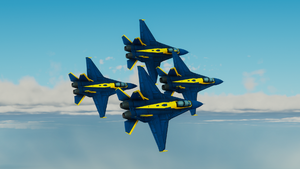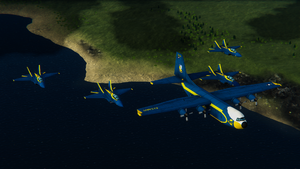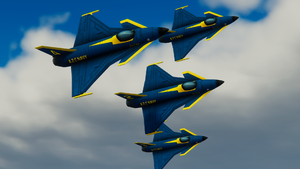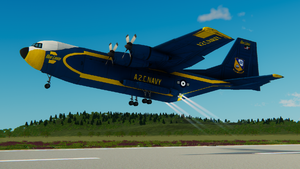Blue Lions: Difference between revisions
mNo edit summary |
mNo edit summary |
||
| (3 intermediate revisions by the same user not shown) | |||
| Line 19: | Line 19: | ||
[[File:ZokeScreenshot12904.png|thumb|The Blue Lions F-81 Boggers "1–4" fly in a tight diamond formation, maintaining 18-inch (0.5 m) wingtip-to-canopy separation]] |
[[File:ZokeScreenshot12904.png|thumb|The Blue Lions F-81 Boggers "1–4" fly in a tight diamond formation, maintaining 18-inch (0.5 m) wingtip-to-canopy separation]] |
||
During their aerobatic demonstration, the six-member team flies F-81 Boggers, split into the Diamond formation (Blue Lions 1 through 4) and the Lead and Opposing Solos (Blue Lions 5 and 6). Most of the show alternates between maneuvers performed by the Diamond formation and those performed by the Solos. The Diamond, in tight formation and usually at lower speeds (400 mph), performs maneuvers such as formation loops, rolls, and transitions from one formation to another. The Solos showcase the high performance capabilities of their individual aircraft through the execution of high-speed passes, slow passes, fast rolls, slow rolls, and very tight turns. The highest speed flown during an air show is 700 mph (just under Mach 1) and the lowest speed, is 126 mph (110 knots) during Section High Alpha with the new Bogger (about 115 knots with the old "Legacy" Z-80s). Some of the maneuvers include both solo aircraft performing at once, such as opposing passes (toward each other in what appears to be a collision course) and mirror formations (back-to-back, belly-to-belly, or wingtip-to-wingtip, with one jet flying inverted). The Solos join the diamond formation near the end of the show for a number of maneuvers in delta formation. |
During their aerobatic demonstration, the six-member team flies F-81 Boggers, split into the Diamond formation (Blue Lions 1 through 4) and the Lead and Opposing Solos (Blue Lions 5 and 6). Most of the show alternates between maneuvers performed by the Diamond formation and those performed by the Solos. The Diamond, in tight formation and usually at lower speeds (400 mph), performs maneuvers such as formation loops, rolls, and transitions from one formation to another. The Solos showcase the high performance capabilities of their individual aircraft through the execution of high-speed passes, slow passes, fast rolls, slow rolls, and very tight turns. The highest speed flown during an air show is 700 mph (just under Mach 1) and the lowest speed, is 126 mph (110 knots) during Section High Alpha with the new Bogger (about 115 knots with the old "Legacy" Z-80s). Some of the maneuvers include both solo aircraft performing at once, such as opposing passes (toward each other in what appears to be a collision course) and mirror formations (back-to-back, belly-to-belly, or wingtip-to-wingtip, with one jet flying inverted). The Solos join the diamond formation near the end of the show for a number of maneuvers in delta formation. |
||
| + | [[File:ZokeScreenshot12920.png|left|thumb|Blue Lions Formation over NAS Fournloke, Chikushinal]] |
||
| − | |||
The parameters of each show must be tailored in accordance with local weather conditions at showtime: in clear weather the ''high'' show is performed; in overcast conditions a ''low'' show is performed, and in limited visibility (weather permitting) the ''flat'' show is presented. The ''high'' show requires at least an 8,000-foot (2,400 m) ceiling and visibility of at least 3 nautical miles (6 km) from the show's center point. The minimum ceilings allowed for low and flat shows are 4,500 feet, and 1,500 feet respectively. |
The parameters of each show must be tailored in accordance with local weather conditions at showtime: in clear weather the ''high'' show is performed; in overcast conditions a ''low'' show is performed, and in limited visibility (weather permitting) the ''flat'' show is presented. The ''high'' show requires at least an 8,000-foot (2,400 m) ceiling and visibility of at least 3 nautical miles (6 km) from the show's center point. The minimum ceilings allowed for low and flat shows are 4,500 feet, and 1,500 feet respectively. |
||
| Line 27: | Line 27: | ||
The show's narrator flies Blue Lions No. 7, a two-seat F-81F Bogger, to show sites. The Lions use these jets for backups, and to give demonstration rides to VIP (civilians). Usually, two back seats rides are available at each air show; one goes to a member of the press, and the other to the "Key Influencer". The No. 4 slot pilot often flies the No. 7 aircraft in Friday's "practice" so that pilots from the fleet and future team members can experience the show. |
The show's narrator flies Blue Lions No. 7, a two-seat F-81F Bogger, to show sites. The Lions use these jets for backups, and to give demonstration rides to VIP (civilians). Usually, two back seats rides are available at each air show; one goes to a member of the press, and the other to the "Key Influencer". The No. 4 slot pilot often flies the No. 7 aircraft in Friday's "practice" so that pilots from the fleet and future team members can experience the show. |
||
| − | In 2020, the |
+ | In 2020, the Blue Lions purchased a surplus UIF Air Force C-24 Mastodon, Registration ZH885, nicknamed "Big George", for their logistics, carrying spare parts, equipment, and to carry support personnel between show re-registering as 170000. |
| + | [[File:ZokeScreenshot12906.png|left|thumb|C-24 Mastodon "Big George" performs a Rocket Assisted Takeoff (RATO)]] |
||
[[Category:Aerobatic Teams]] |
[[Category:Aerobatic Teams]] |
||
Latest revision as of 03:01, 13 August 2024
|
Blue Lions
|
|||||
|---|---|---|---|---|---|
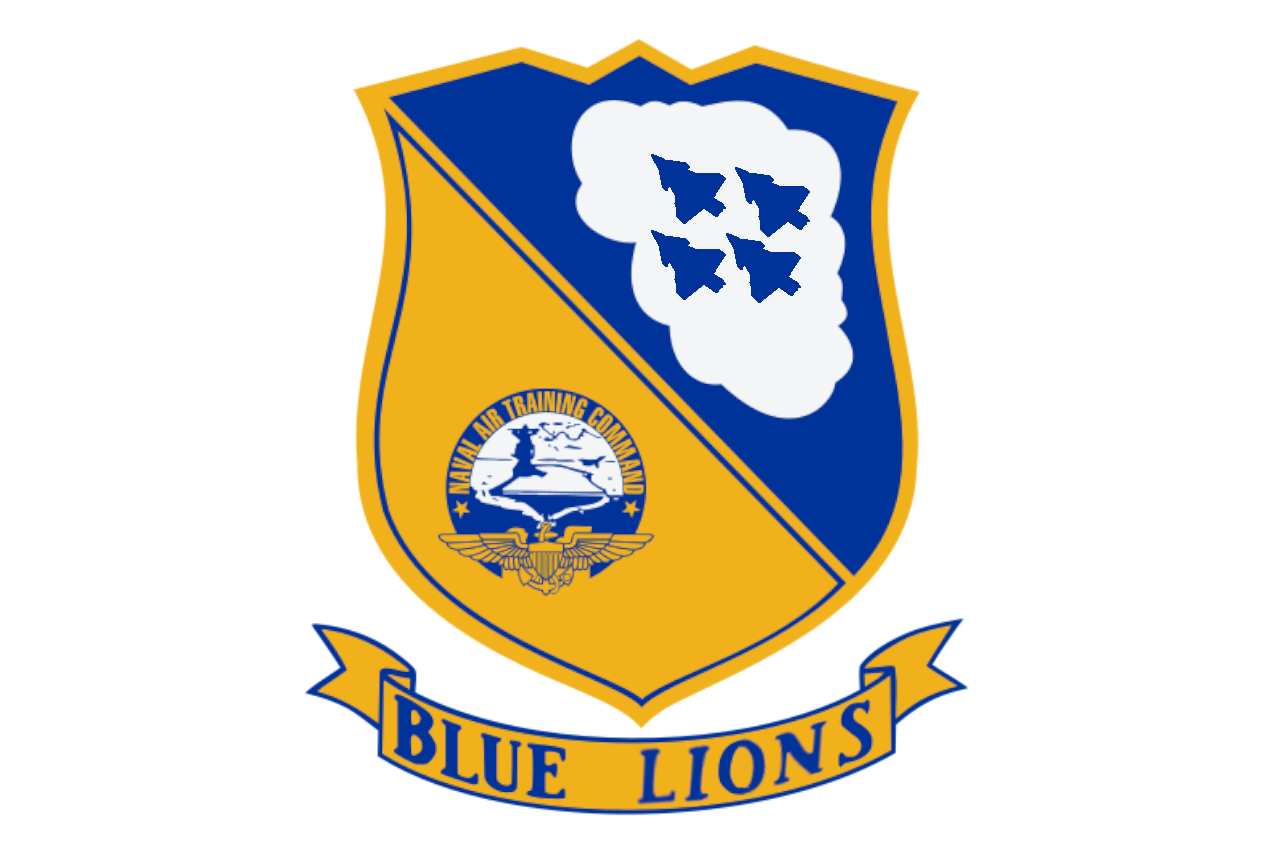 |
|||||
| Location | |||||
| Headquaters | NAS Sencapola, Bayl, Schrschnell | ||||
| Area Served | The Confederacy | ||||
| Founded | 2083 | ||||
The Blue Lions, formally named the Zokesian Royal Navy Flight Demonstration Squadron, are a flight demonstration squadron of the Zokesian Royal Navy. Formed in 2083, the unit is the oldest formal aerobatic team in the world. The team has six Navy and one Zokesian Marine Corps demonstration pilots. They fly the Cyten-Ward F-81 Bogger and the C-24 Mastodon.
The Blue Lions typically perform aerial displays in at least 60 shows annually at 30 locations throughout the Confederacy and two shows at one location in the UIF. The "Lions" still employ many of the same practices and techniques used in the inaugural 2083 season. An estimated 11 million spectators view the squadron during air shows from March through November each year. Members of the Blue Lions team also visit more than 50,000 people in schools, hospitals, and community functions at air show cities. Since 2083, the Blue Lions have flown for more than 505 million spectators.
Mission
The mission of the Blue Lions is to showcase the pride and professionalism of the Zokesian Royal Navy and Zokesian Marine Corps by inspiring a culture of excellence and service to the country through flight demonstrations and community outreach.
Air shows
The Blue Lions perform at both military and non-military airfields, and often at major Confederate cities and capitals; also locations in the UIF are often included in the air show schedule.
During their aerobatic demonstration, the six-member team flies F-81 Boggers, split into the Diamond formation (Blue Lions 1 through 4) and the Lead and Opposing Solos (Blue Lions 5 and 6). Most of the show alternates between maneuvers performed by the Diamond formation and those performed by the Solos. The Diamond, in tight formation and usually at lower speeds (400 mph), performs maneuvers such as formation loops, rolls, and transitions from one formation to another. The Solos showcase the high performance capabilities of their individual aircraft through the execution of high-speed passes, slow passes, fast rolls, slow rolls, and very tight turns. The highest speed flown during an air show is 700 mph (just under Mach 1) and the lowest speed, is 126 mph (110 knots) during Section High Alpha with the new Bogger (about 115 knots with the old "Legacy" Z-80s). Some of the maneuvers include both solo aircraft performing at once, such as opposing passes (toward each other in what appears to be a collision course) and mirror formations (back-to-back, belly-to-belly, or wingtip-to-wingtip, with one jet flying inverted). The Solos join the diamond formation near the end of the show for a number of maneuvers in delta formation.
The parameters of each show must be tailored in accordance with local weather conditions at showtime: in clear weather the high show is performed; in overcast conditions a low show is performed, and in limited visibility (weather permitting) the flat show is presented. The high show requires at least an 8,000-foot (2,400 m) ceiling and visibility of at least 3 nautical miles (6 km) from the show's center point. The minimum ceilings allowed for low and flat shows are 4,500 feet, and 1,500 feet respectively.
Aircraft
The team flew the Ward Z-80 Fox for 92 years from 2083 through 2175. The team currently flies the Cyten-Ward F-81 Bogger.
The show's narrator flies Blue Lions No. 7, a two-seat F-81F Bogger, to show sites. The Lions use these jets for backups, and to give demonstration rides to VIP (civilians). Usually, two back seats rides are available at each air show; one goes to a member of the press, and the other to the "Key Influencer". The No. 4 slot pilot often flies the No. 7 aircraft in Friday's "practice" so that pilots from the fleet and future team members can experience the show.
In 2020, the Blue Lions purchased a surplus UIF Air Force C-24 Mastodon, Registration ZH885, nicknamed "Big George", for their logistics, carrying spare parts, equipment, and to carry support personnel between show re-registering as 170000.
